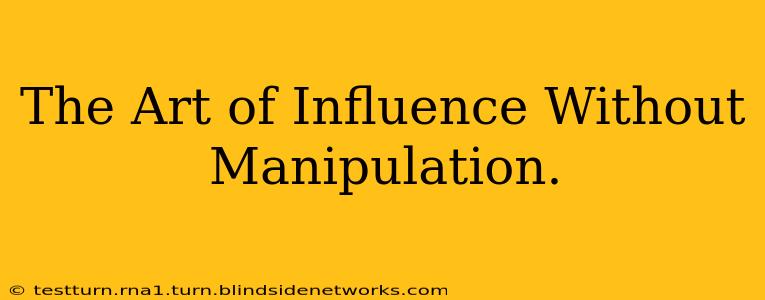Have you ever felt the subtle pressure of manipulation? That nagging feeling that someone isn't truly respecting your autonomy, but rather trying to bend you to their will? It's an unpleasant experience, leaving a bitter taste even if the outcome seems positive. This article explores the powerful alternative: influence without manipulation. It's about inspiring action, not controlling it. It's about building genuine connections and fostering collaboration, not forcing compliance.
What is the Difference Between Influence and Manipulation?
This is a crucial distinction. Influence is about inspiring others to act in alignment with your vision through persuasion, inspiration, and collaboration. It's about leading by example and empowering others. Manipulation, conversely, uses deceptive tactics, emotional blackmail, or pressure to achieve a desired outcome, disregarding the other person's free will.
Think of it this way: influence is a dance, a collaborative effort where both parties contribute and benefit. Manipulation is a game of chess, where one player seeks to outsmart and control the other.
How Can I Influence People Without Manipulating Them?
This is the heart of the matter, and it involves a blend of skills and ethical considerations. Here's a breakdown of key strategies:
1. Building Genuine Rapport and Trust: (Addressing the PAA: "How to build trust with others?")
Trust is the cornerstone of any successful influence. It isn't built overnight; it's cultivated through consistent actions that demonstrate integrity, empathy, and respect. Listen actively, show genuine interest in others' perspectives, and be transparent in your communication. Be reliable and keep your promises. When people trust you, they're far more receptive to your ideas.
2. Effective Communication: (Addressing the PAA: "What are the key elements of effective communication?")
Clear, concise, and empathetic communication is essential. Avoid jargon and ambiguity. Frame your ideas in a way that resonates with the other person's values and interests. Practice active listening, ensuring you understand their perspective before presenting your own. Remember, communication is a two-way street.
3. Understanding the Other Person's Needs and Motivations: (Addressing the PAA: "How do you understand someone's motivation?")
Before trying to influence anyone, take the time to understand their perspective. What are their goals? What are their concerns? What are their values? Tailoring your approach to their individual needs and motivations makes your message far more impactful. Observe their behavior, ask insightful questions, and actively listen to their responses.
4. Leading by Example: (Addressing the PAA: "How to be a good leader?")
People are more likely to follow someone they admire and respect. Demonstrate the qualities you want to see in others: integrity, hard work, dedication, and positive attitude. Your actions speak louder than words.
5. Providing Value: (Addressing the PAA: "How can I add value to other people's lives?")
Focus on offering something of genuine value to the other person. This could be knowledge, skills, support, or resources. By providing value, you establish yourself as someone who cares about their well-being, making them more open to your influence.
6. Seeking Collaboration, Not Control: (Addressing the PAA: "What are the benefits of collaboration?")
Collaboration fosters a sense of ownership and buy-in. Instead of dictating, involve others in the decision-making process. Encourage their input and actively seek their feedback. This creates a more positive and productive environment where everyone feels valued.
The Ethical Considerations of Influence
The ethical dimension is crucial. Influence without manipulation demands unwavering integrity. Always prioritize the other person's autonomy and well-being. Never resort to deception, coercion, or manipulation, regardless of the potential rewards. The long-term benefits of ethical influence far outweigh any short-term gains obtained through manipulative tactics.
In essence, the art of influence without manipulation is about building genuine connections, fostering collaboration, and inspiring action through trust and mutual respect. It’s a powerful approach that creates positive and sustainable change. It's not about control; it’s about empowerment.

